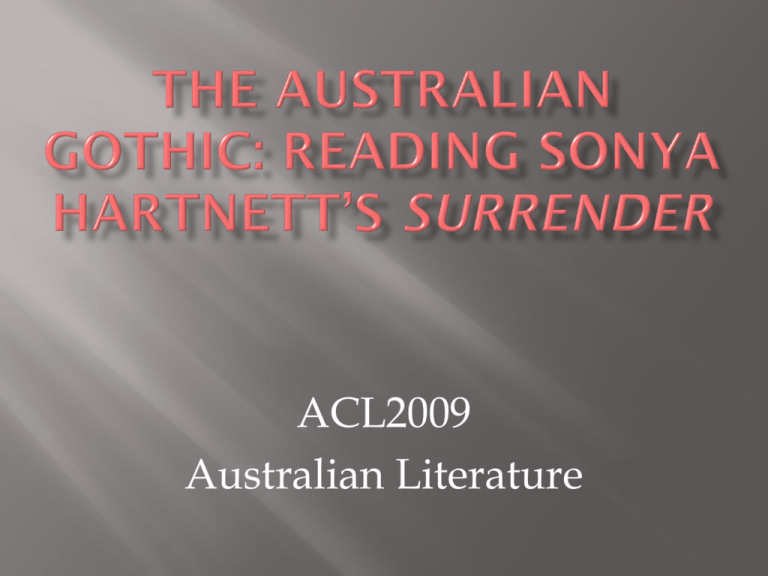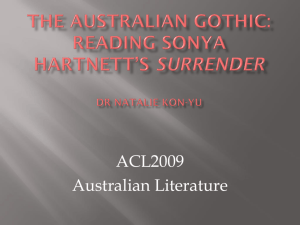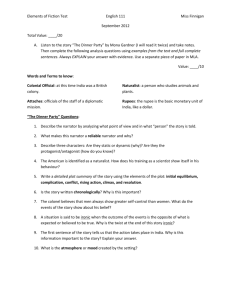Surrender * Sonya Hartnett dr Natallie Kon-yu
advertisement

ACL2009 Australian Literature Gothic Fiction Australian Gothic Fiction ‘Cold Snap’ Cate Kennedy Surrender Sonya Hartnett ‘The Gothic had developed as a popular narrative form in Britain towards the end of the 18th Century, specialising in an intense blend of the supernatural, family romance and gloomy atmospherics.’ (Gelder and Weaver, 2007, p.3) Gothic texts include The Red Death and The Fall of the House of Usher (Edgar Allen Poe); Frankenstein (Mary Shelley) and Dracula (Bram Stoker) – though of course Dracula can also be cast as Vampire Fiction. Other Gothic texts? Dark settings, often rural. Crumbling buildings – castles and ruined abbeys to signify a falling aristocracy. The creation of Monsters – Frankenstein and Dracula. The creation of doubles – as Monleon writes ‘The monsters were possible, because we were the monsters’ ( p.24) Marx and Engels write that: The development of Modern Industry, therefore, cuts from under its feet the very foundation on which the bourgeoisie produces and appropriates products. What the bourgeoisie, therefore, produces, above all, is its own grave-diggers. (1968, p.46) We can read here that the Gothic is a reaction to the Industrial Revolution, especially the division of rich and poor which becomes particularly evident in the city. Monleon suggests that Gothic and other dark fiction expressed a middle-class fear of the rising power of the poor/working classes. Gothic writing, was in part, a reaction to the Industrial revolution which encompasses: The move from country to city. The emergence of a working class. The visible difference between classes of British society. As we saw in Poetry and Poetics, many writers used harsh imagery to portray London’s city scape in the late 18th and early 19th Centuries. What do all these pictures have in common? We see buildings in all the images, mostly from below. What is the effect of this? We also see some hint of landscape in these pictures – but these images are also dark and forlorn. In 1856 Frederick Sinnett dismissed the idea that Gothic Fiction could ever flourish in Australia: There may be plenty of dilapidated buildings, but not one, the dilapidation of which is sufficiently venerable by age, to tempt the wandering footsteps of the most arrant parvenu of a ghost that ever walked by night. It must be admitted that Mrs. Radcliffe’s genius would be quite thrown away here; and we must reconcile ourselves to the conviction that the foundations of a second ‘Castle of Otranto’ can hardly be laid in Australia at our time. However, the Gothic did emerge in Colonial Australia – and Gelder and Weaver point to John Lang’s story ‘The Ghost Upon the Rail’ (1859) as perhaps the first example of Australian Gothic fiction. (2007, p.3). In their anthology of Colonial Australian Gothic Fiction, Gelder and Weaver include a number of stories from the 19th Century to the early 20th Century. The anthology includes stories from Henry Lawson, Katharine Susannah Prichard and Barbara Baynton. Significantly, in Australian Gothic Fiction, the bush hut, or even the bush itself, is the setting of the horrific stories. This moves away from the dilapidated mansions that were popular in British and American texts. It also fits in with the notions of Australia as Hell that have been introduced earlier in this unit. ‘Cold Snap’ the short story by Cate Kennedy, is a good example of contemporary gothic fiction. The opening paragraph is ominous – a child is checking his rabbit traps. ‘The rabbit carcasses steam when we rip the skin off and it comes away like a glove’ (p, 87). The imagery of the bush is dark and forbidding: ‘the trees look dark and sunken in, as if they’re hanging on by shutting off their minds, like my grandpop when he had the stroke’ (p.88). There’s a fair amount of cruelty in this story – take the boy’s father who rigs the chip heater so that it burns the hands of one of Billy’s classmates: There was a scream and the boy came running outside holding his hands in front of him. And they were bright pink like plastic. As the boy ran past, my dad called, Don’t forget to tell your friends. (p.89). The violence in the story escalates to the point at which Billy kills the city woman by planting a rabbit trap, so that she swerves to miss it and crashes into a tree. (pp. 93-94) Like ‘Cold Snap’ Surrender is also set in the bush, and also features children at the centre of the text. The story is told from two perspectives – Gabriel’s and Finnigan’s, and the narrative starts with Gabriel on his death bed, waiting for Finnigan to visit him. The story then dips back into the past, starting with the meeting of Gabriel (Anwell) and Finnigan outside Anwell’s house. From this first meeting we know that Anwell has done something terrible, and that the townspeople have distanced themselves from his family. Like many Gothic stories set in the outback, Mulyan is characterised as a harsh and isolated place to grow up: Nobody chooses to come here. In this little town ringed by shark-tooth mountains we are far, far away. We only know each other. And the names on the gravestones stay the same. (p.8). The rocks are black with rotten moss . . . The winter sun glows but down here all is gloom. The air smells clean, like spring water, cold, like a mountain’s mood . . . The twigs are broken and the earth is scuffed. (p.44). Interestingly, we don’t know when the story is set: the names of the characters Finnigan, Gabriel, Anwell, Vernon and Evangeline are all old names, yet the action could take place at any moment in history. As readers we are given no clue about the world surrounding Mulyan. This adds to the isolation of the town, and points to its estrangement. Much of the story centres upon the relationship of the two boys, and highlights Gabriel (Anwell’s) estrangement from his family, and from the townspeople. The boys make a pact which has deadly consequences. ‘You will only be good things – you’ll never get angry or fight. And I will only be bad things – I will always get angry and fight. We’ll be like opposites - like pictures in the water’ (pp. 38-39). True to their deal, the boys stick to their roles, but as readers we soon learn that Finnigan wreaks havoc on Mulyan by lighting fires. More specifically, Finnigan’s fires seem to punish the townsfolk who have wronged Gabriel (pp79-84). At the same time that Gabriel is recalling Finnigan’s fires, he is also reflecting the sinister events of his past. The death of his brother, the cold abuse of his parents as well as the events which have cast him and his family as kooks. When we first meet Finnigan, we are told that he and Gabriel are ‘the same height and the same age and built along similar leggy lines, but he was a hyena, while I was a small, ashy, alpine moth’ (p.11). Finnigan, however, does not seem to have a family and he does not go to school. As the novel progresses, he becomes more feral and unreal. Scenes, such as when Finnigan is in McIllwraith’s roof, start to seem implausible. Finally, when Gabriel is ordered by his father, to kill their dog, Surrender, he leaves it with Finnigan. As I drew closer to home, the tall forest petering and becoming the squat stained weatherboards of Mulyan’s poor fringe, the sound of the paws faded until they were finally gone. His body stood beside me, true - but his spirit had returned to Finnigan. And it was the spirit that mattered, I had to believe. I had to make myself believe the body did not matter. “Good dog,” I murmured: “Stay with Finnigan” (p. 226). At this point we know that Finnigan is imagined, as is Gabriel – they form two halves of the boy, Anwell. The creation of Finnigan becomes a way for Anwell to distance himself from the terrible thing he did – the accidental murder of his mentally retarded brother. When Anwell meets Evangeline, he longs to be free of Finnigan, but he cannot be. It is at this point that Anwell (Gabriel) snaps, and murders his parents. The pact is violated, and Gabriel is taken to the police station, and is finally imprisoned. As Gabriel tells us, there is nothing wrong with him – he is not in a hospital, rather he is imprisoned and willing himself to die. Gabriel tells Finnigan : ‘I’m dying to kill you’ (p.218). In the end, Anwell is visited by his brother, Vernon. ‘When he speaks, it is with Finnigan’s voice. You have two names, so do I.’ . . . Now his voice is smooth, iced, untripping: familiar, like Finnigan’s.’ (p.240) In conclusion, we can see that Surrender shares many characteristics with Australian Gothic fiction. The rural setting is menacing and isolated, and the town is under the siege of the fires – the culprit is never caught out. The doublings in the text: Gabriel/Finnigan and Finnigan/Vernon are a chilling look at the monster within a child, and the psychological damage inflicted on him by his past.







